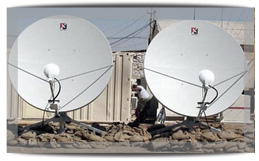Technology Trends
Emerging Trends in Satcom for Military applications
 The rapid strides taken by modern satellite communication is expected to spur greater usage of this medium in the military domain all over the world. Military requirements of failsafe communications has been met by use of multiple means of terrestrial communications. The use of C and Ku band has multiplied as satellite communications have provided an alternate means of connectivity to the traditional terrestrial connectivity.
The rapid strides taken by modern satellite communication is expected to spur greater usage of this medium in the military domain all over the world. Military requirements of failsafe communications has been met by use of multiple means of terrestrial communications. The use of C and Ku band has multiplied as satellite communications have provided an alternate means of connectivity to the traditional terrestrial connectivity.
The growing deployment of armed forces on UN missions and peacekeeping operations led a spurt in large scale usage of satellite communications. The deployment of US and European defense personnel in operations in Iraq and Afghanistan led to usage of satellite communications of very high demand for high bandwidth connectivity for the purposes of intra-communications between field forces as well as connectivity for controlling HQs with their respective nations. A new area of usage emerged with the development of welfare communications to provide Internet connectivity to the defense personnel in the field for their personal communications with their families and for personal recreation.
The future of usage of satellite communications is expected to increase rapidly with the need for highly reliable communications with high bandwidth for the main purpose of providing C4ISR (Command Control Communications Computers Intelligence Surveillance and Reconnaissance) capabilities and network based warfare. This is expected to get a fillip from the deployment of Ka band satellite capability under several programs including the Inmarsat Global Express and a joint French Italian project. Multi-national deployments which are turning into the norm will require networks to be interoperable by forces of several nations and will increasingly turn to standard protocols. These will definitely be fully secure, adaptable and scalable for greater usability.
The communication requirements of military forces of developing countries are increasingly turning to satellite communications to meet their operational requirements. Requirements of mobile satellite antennae and satellite-on-the-move (SOTM) have been seen to increase over the recent years as most military forces try to recast themselves into more mobile and flexible battle groups and formations for deployment both within their own borders and outside their countries as part of multi-national forces. The preliminary steps for C4ISR is also seen in modern military forces with satellite communications at the backbone.
The prospects of satellite communications to cater to military requirements all over the world are therefore on an upward path. Deployment of Ka band satellites in future is bound to increase with use of both high bandwidth trunk connectivity as well as low bandwidth applications for isolated stations. VSAT networks with increased security and intermeshed voice and data applications will have greater deployment possibilities with the military forces especially of the developing world largely in Ku band. The developed nations are more likely to use advanced Ka band technology for their overseas deployments.
Satellite communications is thus shifting from being a backup means to a frontline primary means of communication for military forces all over the world due to the shift in the employment of these forces over the last decade which will tend to be the norm in the future.

